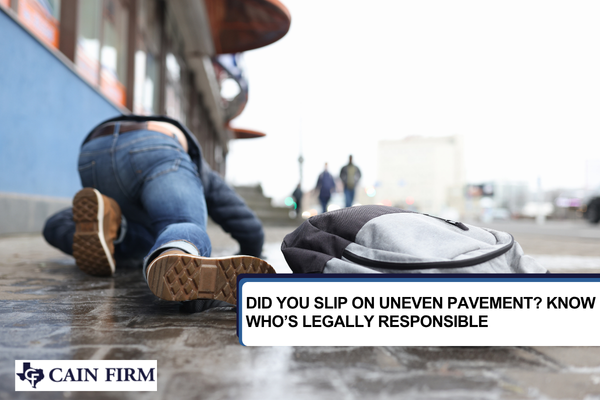What Is ‘Assumption of The Risk’ in Personal Injury Law
Understanding assumption of the risk in Texas personal injury cases
When someone is injured in an accident, one of the defenses often raised by defendants is “assumption of the risk.” This legal doctrine can limit or even eliminate a plaintiff’s ability to recover compensation if they voluntarily participated in a risky activity and understood the dangers involved. If you were injured and are concerned about how assumption of the risk may affect your case, our Fort Worth personal injury lawyers can help you understand your legal rights and fight for the compensation you deserve.
If you have questions about your personal injury case, contact the Cain Firm today for a free consultation.
Frequently asked questions about assumption of the risk
We stand ready to protect your rights, prove fault, and collect maximum tax-free payment for your injury claims.

MEET OUR ATTORNEY
Brett Cain
What is "assumption of the risk"?
Assumption of the risk is a legal doctrine that applies when an individual voluntarily takes responsibility for the known dangers associated with an activity. This means that by engaging in the activity, the person acknowledges the risks and understands that they may suffer an injury or loss as a result.
There are two types of assumption of the risk: express and implied. Express assumption of the risk occurs when someone explicitly acknowledges the danger, such as signing a waiver before participating in an activity. Implied assumption of the risk applies when no written agreement is in place, but the person’s actions indicate that they understood and accepted the risks involved.
What factors determine assumption of the risk in Texas?
Several factors influence whether the assumption of the risk applies in a Texas personal injury case, including:
- The type of activity involved: Was the activity inherently risky, such as skydiving or rock climbing?
- The plaintiff’s knowledge and experience: Did the plaintiff have prior experience or training in the activity?
- Pre-established rules: Were there safety regulations or specific guidelines participants were expected to follow?
- Warnings about potential dangers: Were participants made aware of risks before engaging in the activity?
- The defendant’s conduct: Did the defendant behave negligently or recklessly, increasing the risk of injury?
Courts in Texas evaluate these factors on a case-by-case basis when determining whether assumption of the risk applies to a personal injury claim.
What is primary assumption of the risk?
Primary assumption of the risk occurs when an individual voluntarily participates in an activity with full knowledge of the potential dangers involved. This often applies to inherently dangerous activities, such as contact sports or extreme recreational activities. In these cases, the participant is generally barred from seeking compensation for injuries sustained during the activity. For this defense to apply, the defendant must prove:
- The plaintiff knowingly assumed the risk
- The defendant had no duty to protect or warn the plaintiff
- The defendant did not breach any duty of care
- The injury was not caused by negligence on the defendant’s part
What is secondary assumption of the risk?
Secondary assumption of the risk applies when a plaintiff knowingly engages in a risky activity but does so despite the defendant’s negligence. Unlike primary assumption of the risk, secondary assumption does not automatically bar recovery. Instead, it may reduce the amount of compensation the plaintiff receives based on their share of fault.
For example, if someone participates in an activity without proper training or disregards safety warnings, they may be found partially responsible for their injuries. In such cases, the court may reduce the plaintiff’s compensation based on their degree of fault.
When does the doctrine not apply?
Assumption of the risk is not always an absolute defense against liability. In certain situations, a defendant may still be held responsible for injuries despite the plaintiff’s awareness of risk. These situations include:
- When the defendant acted with gross negligence or recklessness
- When the defendant intentionally created additional hazards
- When the plaintiff was misled or not properly warned about potential dangers
For example, if a business owner knowingly allows hazardous conditions to persist on their property without warning customers, they may still be held liable even if the plaintiff was aware of some risks.
What if the plaintiff signed a liability waiver?
Liability waivers are common in activities such as sports, fitness centers, and recreational attractions. While signing a waiver can indicate express assumption of the risk, it does not automatically prevent a plaintiff from pursuing compensation. Courts in Texas examine waivers to determine their validity based on factors such as:
- Whether the waiver was clearly written and understood
- Whether the plaintiff voluntarily signed it
- Whether the waiver unlawfully attempts to release liability for gross negligence or intentional harm
Even if a valid waiver exists, plaintiffs may still have legal grounds for a claim if they can prove the defendant acted negligently or recklessly.
Contact the Cain Firm for a free case consultation
If you have been injured in an accident and are unsure how assumption of the risk may impact your case, our Fort Worth personal injury lawyers can provide the legal guidance you need. Every case is unique, and our attorneys will evaluate the details of your situation to determine the best path forward.
At the Cain Firm, we fight to protect the rights of injury victims and pursue the maximum compensation they deserve. Contact us today for a free consultation to discuss your legal options.
Personal Injury Blog Posts:

Did You Slip on Uneven Pavement? Know Who’s Legally Responsible
Slipping on uneven pavement can cause serious injuries and raise questions about liability. This blog explains who may be legally

What to Expect When Filing a Personal Injury Lawsuit in Texas: Step-by-Step Guide
Wondering what to expect when filing a personal injury lawsuit in Texas? This step-by-step guide from the Cain Firm covers

How to Obtain an Insurance Settlement in Texas
There are over 6 million car accidents in the United States each year. Over a quarter million of those accidents